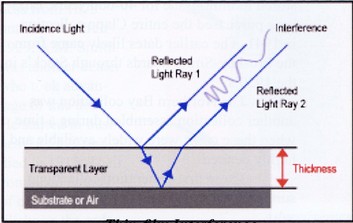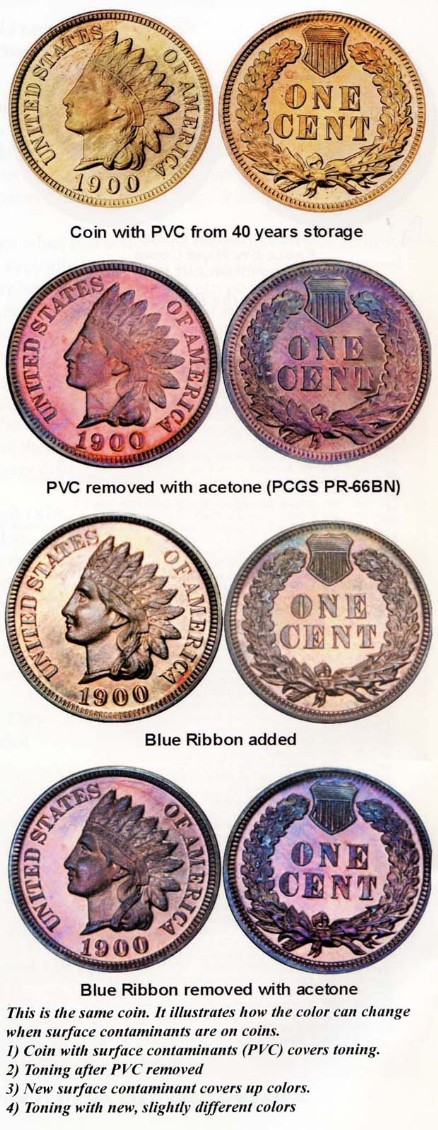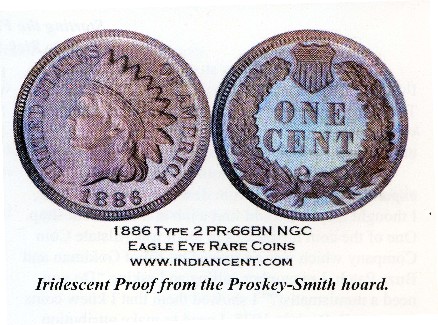Infopages
Blue Toned proofs
Blue Toned Proofs by Rick snow
We call them "Blue-Toned Proofs," but in years past they were called "Iridescent Proofs." These are copper and bronze coins that have a deep chocolate brown patina with colors that are variously lavender blue, dark blue, purple, magenta and emerald. As discussed it the Northern Bay Collection article of the April 2011 Ledger, they can sometimes raise quite a controversy. They are found on specific dates in the Indian and Lincoln cent series, as well as some Proof copper patterns from the 19th century from both US and Foreign mints.
The cause of this unusual toning is simply explained when you understand their source. Long term storage in mint tissue caused these coins to tone wonderfully. Typically Proof coins sold as singles were wrapped in tissue and inserted into small envelopes. Minor sets were wrapped together and placed in slightly larger envelopes. Whole sets were wrapped together in single tissues and put in a letter-sized envelope.
There are variations in the coins depending on how they were sold. Some Proofs only had colors on one side, these likely rested on another coin during its storage. Some have different color on each side, like magenta on the obverse and lavender on the reverse. There are innumerable possibilities. For the Indian and Lincoln cents, most of the toned proofs are in the 1878-1915 years. A few surface now and then from 1864 and 1865, but mostly the dates in between are very difficult to find with iridescent toning.
The reason that most dates of toned proofs are dated 1878 and later is because of a change in Mint policy in 1878. That year, they began to account for proofs as currency, adding their numbers to the total mintage for the years coinage. Because of this, any leftover coins at the end of the year had to be issued. Starting in 1878, mintages for minor proofs (Cent, Three cent, and Five Cents) started to explode! Mintages were in the 2000-3000 range. Dates like 1883, where three different Five Cent pieces were made, cent mintage was a record at 6.609.
A few dealers struck a deal with the mint in 1878. They would buy the leftover minor sets for face value at the end of the year. These dealers included David Proskey, who was in business from 1873 until his death in 1929. A.M. Smith was another dealer who took advantage of this deal. He started in business in1879 and died in1929 Their combined hoards of cents were likely on the order of 3000 to 7000 pieces. Sounds like a lot, but that was only a $30 to $70 investment over 30 years. Their hoards were held for many years. Smith retained most of his coins and these were sold by M.H. Bolender in 1935. Bolender was a dealer in Orangeville, IL who did mail order sales. Proskey's hoard was held until his death and then was sold to Wayte Raymond. These coins had been stored in mint tissue for between 20 and 50 years. The nickel coins survived untoned, but the copper cents all acquired a deep brown patina with the wonderful iridescent colored toning. A young Abe Kosoff started dealing in the 1930's. In Abe Kosoff: Dean of Numismatics, Author Q. David Bowers related a story about one of Kosoff's early transactions. In Kosoff's first week in business, he purchased a large amount of minor proofs from Joe Silvermanwho operated a shop at 1 East 29th St. in New York City. At the time there was an overabundance of iridescent Proofs due to the selective leaking of portions of the various hoards. Koskoff bought Silverman's hoaerd for $1000 an ran ads in Numismatic Scrapbook. He was overwhelmed with orders.
Many collections that were being assembled at the time included iridescent Proofs rather than full red examples. Louis Eliasberg's collection is a great example of one that survived until recent times. The dates that came from the Clapp collection (1892-1906) were not iridescent, while the earlier ones were. The reason for this is that the John H. Clapp collection was bought directly from the Mint, and were not stored in mint tissue for 40 odd years. Eliasberg purchased the entire Clapp collection in 1941.The earlier dates came from Proskey-Smith hoards through Stack" in the 1930's The North Bay collection was another collection assembled during a time when these coins were widely available and highly desired. These first generation collections survived in various states of preservation. For the most part, storage was not too destructive to the coins and the importance of preserving the toning meant that they were not mishandled.
When these collections came up for sale in later years, the iridescent toned Proof brought good premiums. For example the April 1962 Stack's sale had a good collection of these coins. However by the 1970's, these coins had been mostly distributed and very few hoards existed. However the intervening 50 years of activity since the 1930's made many of these coins become dull with only a hint of their former vibrancy. PVC flips caused oils and scum to leach out on the coins, making them sticky and foul. For many of these coins, the end result was coins that were mostly brown with just a hint of color.
There are many ways to remove surface debris. When these dull coins are lightly washed in soapy solutions, they come back to their original brilliance. Sometime the difference is very surprising. Now, this is were the confusion starts. Are you creating the toning by removing gunk that is covering it up? The obvious answer in No. But there are other things that effect the color of the copper, which does change the color of a copper coin. I call it the "Acetone effect." It happens when debris on the coin is washed off, but a thin film is left on the coin. You see wild colors similar to the iridescent Proofs. Thin film interference patterns are what you see when a transparent layer is either suspended in air, like a soap bubble, or laid on a surface, like oil on water. The gap between the two surfaces of the transparent layer reflect back the light at different wavelengths. The interference from these different wavelengths create various colors.



How can you tell the difference? The Proskey-Smith coins all have a deep brown patina under the iridescence, so that helps a bit. The acetone effect toning is more delicate and can be disturbed with just a swipe of your finger. ( I am not advising this as a test, though ). The oils on your finger will disturb the thin film interference pattern and the colors will go away. Blue Ribbon Coin Preserver (Coin Care) is an oily surface preserver that will disturb the acetone effect toning. It will not change the true Iridescent Proof to a great extent. However I do not recommend putting any substance on any Proof, since the mirrors and the eye appeal of the coin will also be affected. The grading services have not been consistent in their opinion of the iridescent Proofs. Prior to the Eliasberg sale in 1996, they didn't think iridescent Proofs were real and didn't grade them. After seeing so many of them in that collection they finally began to grade them consistently.
After the 2006 fiasco described in the The Northern Bay Collection Experience article, they stopped grading iridescent proofs again, or at least reduced the frequency that the Proofs got graded. Recently, PCGS has instituted technology that detects surface contaminants. I have found that iridescent toned Proofs are getting graded easier now since they started this program because they have no surface contaminates. Many collectors have attempted to assemble complete date sets of iridescent toned proofs. Tough dates are 1866-1877 and some dates in the 1890's. The dates in the 1880's with exception of1888 and 1889 are the most common. The 1900's are not too common. The seem to come on the market sporadically. When an old collection comes up for sale, you'll see a few for a while and then they will be gone. I tend to sell them very quickly in the $1000 to $2000 range. I think if prices moved up considerably , we would see more come back on the market.